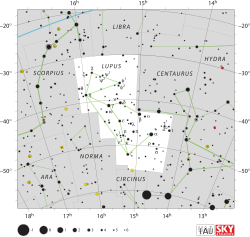|
| Psi1 Lupi (ψ1) |  | Observationsdata
Epok: J2000 |
|---|
| Stjärnbild | Vargen |
|---|
| Rektascension | 15t 39m 45,97886s[1] |
|---|
| Deklination | -34° 24′ 42,9065″[1] |
|---|
Skenbar magnitud ( ) ) | 4,663[2] |
|---|
| Stjärntyp |
|---|
| Spektraltyp | G8/K0 III[3] |
|---|
| B–V | +0,96[4] |
|---|
| Astrometri |
|---|
Radialhastighet ( ) ) | -23,10 ± 0,80[5] km/s |
|---|
| Egenrörelse (µ) | RA: +219,64[5] mas/år
Dek.: +67,34[5] mas/år |
|---|
Parallax ( ) ) | 14,85 ± 0,84[5] |
|---|
| Avstånd | 205,38 lå (63[6] pc) |
|---|
Absolut magnitud ( ) ) | +0,24[7] |
|---|
| Detaljer |
|---|
| Massa | 2,42[7] M☉ |
|---|
| Radie | 13[6] R☉ |
|---|
| Luminositet | 72,92[8] L☉ |
|---|
| Temperatur | 4 930[6] K |
|---|
| Metallicitet | -0,34[4] |
|---|
| Andra beteckningar |
|---|
| ψ1 Lup, 3 Lupi, CD-33 ° 10631, HD 139521, HIP 76705, FK5 3237, HR 5820, SAO 206843 |
Psi1 Lupi (ψ1 Lupi, förkortad Psi1 Lup, ψ1 Lup), som är stjärnans Bayer-beteckning, är en ensam stjärna[2] i norra delen av stjärnbilden Vargen. Den har en skenbar magnitud av 4,66[2] och är synlig för blotta ögat där ljusföroreningar ej förekommer. Baserat på parallaxmätning inom Hipparcosuppdraget på ca 14,9 mas,[5] beräknas den befinna sig på ett avstånd av ca 205 ljusår (63 parsek) från solen.
Egenskaper
Psi1 Lupi är en gul till orange jättestjärna av spektralklass G8/K0 III[3] och befinner sig i röda klumpen. Den har en massa som är ca 2,4[7] gånger solens massa, en radie som är ca 13[6] gånger solens radie och avger ca 73[8] gånger mer energi än solen från dess fotosfär vid en effektiv temperatur på ca 4 900 K.[7]
Psi1 Lupi är omgiven av ett kallt skikt antytt av den lilla observerade effekten av dubbel Mg II-emission med en våglängd av 2 800 ångström. Absorptionskärnorna på topparna i emissionsprofilerna Mg II k och h är huvudsakligen av interstellärt ursprung och beror delvis på egenabsorption i stjärnans kromosfär.[6]
Referenser
- Den här artikeln är helt eller delvis baserad på material från engelskspråkiga Wikipedia, 16 februari 2019.
Noter
- ^ [a b] Van Leeuwen, F. (2007). "Validation of the new Hipparcos reduction". Astronomy and Astrophysics. 474 (2): 653–664. arXiv:0708.1752. Bibcode:2007A&A...474..653V. doi:10.1051/0004-6361:20078357.
- ^ [a b c] Alves, David R. (2000). "K-Band Calibration of the Red Clump Luminosity". The Astrophysical Journal. 539 (2): 732. arXiv:astro-ph/0003329. Bibcode:2000ApJ...539..732A. doi:10.1086/309278.
- ^ [a b] Houk, N. (1982). "Michigan Catalogue of Two-dimensional Spectral Types for the HD stars. Volume_3. Declinations -40_ƒ0 to -26_ƒ0". Michigan Catalogue of Two-dimensional Spectral Types for the HD stars. Volume_3. Declinations -40_ƒ0 to -26_ƒ0. Bibcode:1982mcts.book.....H.
- ^ [a b] Adibekyan, V. Zh.; Benamati, L.; Santos, N. C.; Alves, S.; Lovis, C.; Udry, S.; Israelian, G.; Sousa, S. G.; Tsantaki, M.; Mortier, A.; Sozzetti, A.; De Medeiros, J. R. (2015). "Chemical abundances and kinematics of 257 G-, K-type field giants. Setting a base for further analysis of giant-planet properties orbiting evolved stars". Monthly Notices of the Royal Astronomical Society. 450 (2): 1900. arXiv:1503.08346. Bibcode:2015MNRAS.450.1900A. doi:10.1093/mnras/stv716.
- ^ [a b c d e] https://www.universeguide.com/star/psi1lupi. Hämtad 2019-02-16.
- ^ [a b c d e] Gurzadian, G. A.; Kondo, Y.; Ohanesyan, J. B.; Terzian, Yervant; Perez, Mario R. (1991). "A cool giant with a circumstellar cloud". Astrophysics and Space Science. 176 (1): 61–68. Bibcode:1991Ap&SS.176...61G. doi:10.1007/BF00643077.
- ^ [a b c d] Pizzolato, N.; Maggio, A.; Sciortino, S. (September 2000), "Evolution of X-ray activity of 1-3 Msun late-type stars in early post-main-sequence phases", Astronomy and Astrophysics, 361: 614–628, Bibcode:2000A&A...361..614P
- ^ [a b] McDonald, I.; Zijlstra, A. A.; Boyer, M. L. (2012). "Fundamental parameters and infrared excesses of Hipparcos stars". Monthly Notices of the Royal Astronomical Society. 427: 343. arXiv:1208.2037. Bibcode:2012MNRAS.427..343M. doi:10.1111/j.1365-2966.2012.21873.x.
Externa länkar
|





